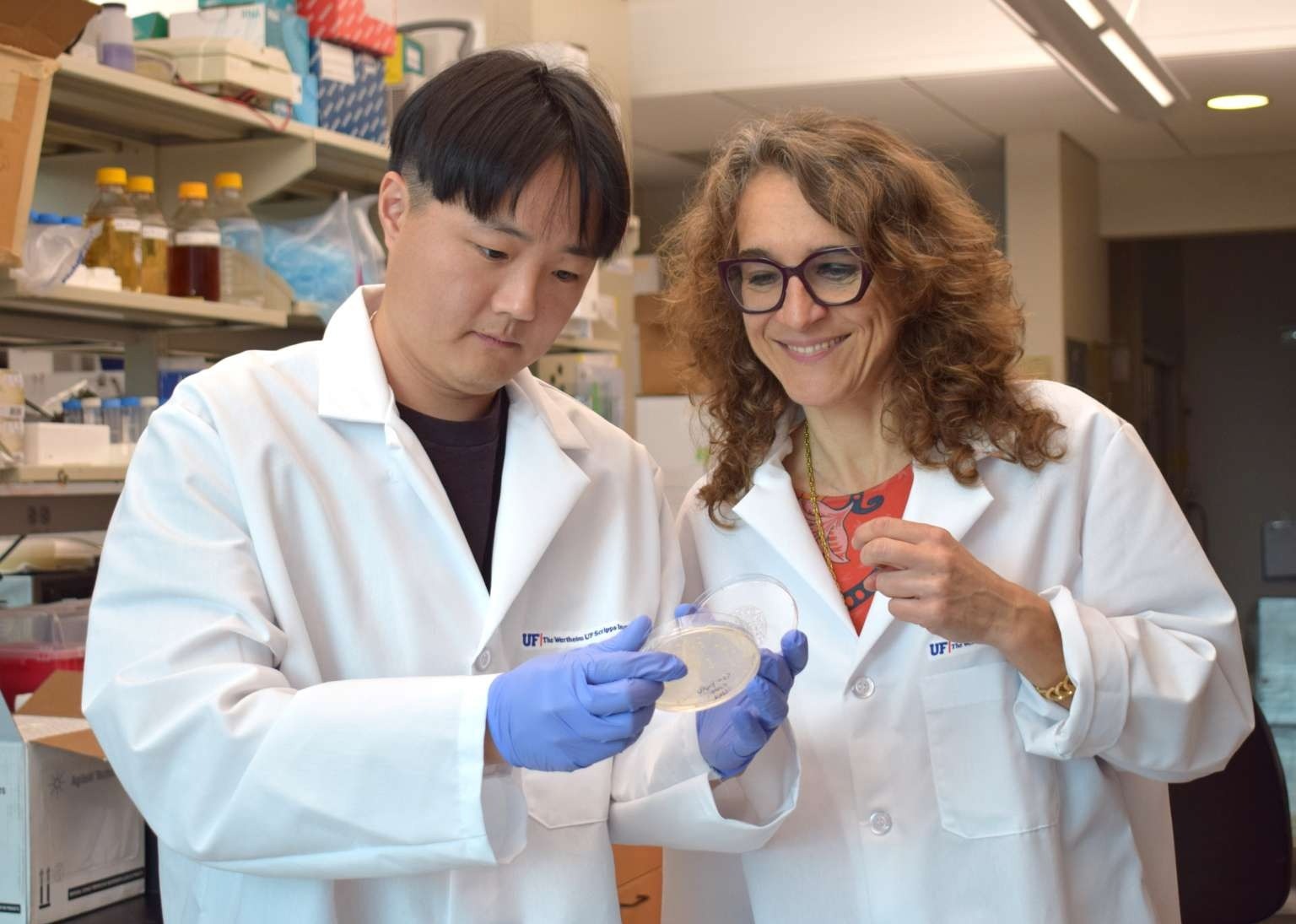Researchers have discovered that if oxidative stress destroys protein factories known as ribosomes, repair crews may go in to assist in repairing the damage so that production may restart rapidly.

Postdoctoral researcher Yoon-Mo (Jason) Yang, PhD, and his advisor, Professor Katrin Karbstein, PhD, review their study results in their lab at The Wertheim UF Scripps Institute in Jupiter, Florida. Image Credit: Scripps Institute in Jupiter
According to the study’s lead author, Molecular Biologist Katrin Karbstein, PhD, a professor at The Herbert Wertheim UF Scripps Institute for Biomedical Innovation & Technology, the discovery, published in the journal Molecular Cell, could have implications for cancer, the aging process, and growth and development.
Literally more than half the mass of all cells are ribosomes. If you don’t have enough ribosomes, or they are malfunctioning, proteins aren’t made correctly, and that can lead to all these diseases. We know that defects in the machinery of ribosomes are found in all cancer cells, for example.”
Katrin Karbstein PhD, Study Lead Author, Molecular Biologist and Professor, The Herbert Wertheim UF Scripps Institute for Biomedical Innovation & Technology
In humans, a single cell may contain up to 10 million ribosomes whirring away, assembling the proteins encoded in genes, one amino acid at a time. While infections, UV light, radiation, and oxidative stress can all harm cells, they have an amazing ability to protect themselves. Damaged items are frequently designated for destruction, broken up, and recycled. However, because ribosomes are so vital to life, eliminating every broken ribosome is troublesome.
Karbstein and team found an alternate method, unique to oxidative stress damage, in their investigation. When highly reactive oxygen molecules created by the energy metabolism process must find stable locations to land, cells experience oxidative stress. Those stable sites are frequently found within proteins. The addition of extra oxygen can alter and harm the receiving molecule. In the case of ribosomes, it can completely halt protein building.
The researchers discovered that ribosomes repair this unwanted damage with helper molecules that behave like chaperones, transporting the damaged segment away from the cell. The ribosome is quickly repaired, and it is back in operation. The cell avoids the more difficult process of breaking down and recreating fully new ribosomes, as well as the risk of losing its ribosome pool unexpectedly.
Typically when proteins are broken, the cell just degrades them. The ribosome is a very large complex of RNAs and proteins, so maybe if a section gets broken you don’t want to throw out the whole thing. It is like changing a flat tire, rather than buying a new car.”
Katrin Karbstein PhD, Study Lead Author, Molecular Biologist and Professor, The Herbert Wertheim UF Scripps Institute for Biomedical Innovation & Technology
The process is driven by biochemistry. The ribosome’s cysteine amino acid molecules are common recipients of these free radical oxygen molecules. Because of oxidative damage, they prefer to disengage from the ribosome and bind to the chaperone molecules when they are nearby. Undamaged amino acids go into their proper positions when they exit the ribosome, closing the gap and restoring protein production.
The biochemical research was made feasible by discoveries made in the lab of chemist Kate Carroll, PhD, who also works at The Wertheim UF Scripps Institute. Carroll’s lab created specialized reagents and techniques for detecting oxidative damage to cysteine amino acids.
Yoon-Mo (Jason) Yang, PhD, a postdoctoral researcher in the Karbstein group, was the paper’s first author. While the finding was achieved in yeast, Yang believes that this ribosome repair system is conserved in many species, including humans. Human neuron studies, for example, have revealed a comparable phenomenon.
Yang notes, “All living organisms are subjected to oxidative stress, so protein damage happens in all living things. We suspect that the ribosome repair mechanisms happen in every living thing, including humans.”
Many questions remain for the scientists to investigate in the future: They discovered two chaperones; are there any more? Because many antibiotics disable ribosomes, do bacterial repair processes assist them to avoid antibiotics? Yeast cells lacking chaperones grow slowly and look to be less fit; may this have an impact on aging, growth, and development? These are only a handful of the questions raised by the discovery, according to Karbstein.
I’m thinking about how we can translate this into the aging paradigm. It’s exactly like filling in a puzzle. You’ve got this piece, then another, and then you say, ‘Oh, that’s how all the pieces come together.’ So, there are many more pieces to be found.”
Katrin Karbstein PhD, Study Lead Author, Molecular Biologist and Professor, The Herbert Wertheim UF Scripps Institute for Biomedical Innovation & Technology
Source:
Journal reference:
Yang, Y.-M., et al. (2023). Chaperone-directed ribosome repair after oxidative damage. Molecular Cell. doi.org/10.1016/j.molcel.2023.03.030.